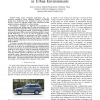262 search results - page 31 / 53 » Navigating dynamic environments using trajectory deformation |
IDA
2003
Springer
14 years 1 months ago
2003
Springer
For a mobile robot to act autonomously, it must be able to construct a model of its interaction with the environment. Oates et al. developed an unsupervised learning method that pr...
AIPS
2011
13 years 7 days ago
2011
Consider the task of a mobile robot autonomously navigating through an environment while detecting and mapping objects of interest using a noisy object detector. The robot must re...
ICRA
2002
IEEE
14 years 1 months ago
2002
IEEE
Dynamical systems theory is used here as a theoretical language and tool to design a distributed control archictecture that generates navigation in formation, integrated with obst...
BICOB
2011
Springer
12 years 8 months ago
2011
Springer
Although the populations of biological systems are inherently discrete and their dynamics are strongly stochastic, it is usual to consider their limiting behaviour for large envir...
RSS
2007
13 years 10 months ago
2007
Abstract— Many urban navigation applications (e.g., autonomous navigation, driver assistance systems) can benefit greatly from localization with centimeter accuracy. Yet such ac...

